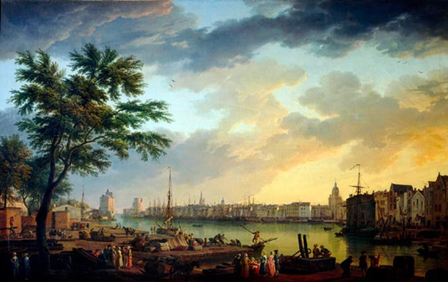Landscapes of Cognac: Tonnay-Charente, the link and La Rochelle seaport
The large port towns of the Charente, such as Cognac, Jarnac, Saintes…, have played a major role in the cognac economy, ensuring the transit of eaux-de-vie to the coast. From this rich past, a particular architectural heritage remains (wharves, wine storehouses, warehouses…), which is nowadays highlighted.

© Michel Guillard
Charente, due to its merchant port, was not enough to convince Colbert. He chose Rochefort to establish a large arsenal.
Tonnay-Charente, the link
The city of Tonnay-Charente, which for a long time was called Charente, was shaped by the river. In the Middle Ages, its position as a border between the possessions of the kings of France and England led to the construction of fortifications, the port being located at the foot of the ramparts. Jean sans Terre, by granting Tonnay a privilege of trade in Saintonge, opens a new era for the fortified town which will become the first commercial port of the region. Salt towards Northern Europe, of the
wines for the English, stones from Saint-Savinien and Crazannes and pastels for Flanders, ceramics from Saintes and paper from Angoulême… From now on, all these goods, return freight from the coasters of the Seudre, transit through Tonnay-Charente.
After some troubled times due to the wars, the town became prosperous again, still thanks to its merchant port, but was not chosen by Colbert to become the great arsenal, which was established in Rochefort. However, during the following century, Tonnay-Charente developed further thanks to the international success of brandies and became the seaport of Cognac. The traffic of barges gives rhythm to the activity and the masts of the boats moored to the very long quays constitute an emblematic urban landscape of the city. Buildings of dressed stone and vast warehouses complete the picture. The steam barge industry did not detract from the prerogatives acquired by Tonnay-Charente as a major river and seaport.
The decline of the port activity will intervene during the XXth century. Today, the landscape of Tonnay-Charente can be appreciated from the suspension bridge. On one side, the roofs of terracotta tiles, the quays lined with old trading houses or other beautiful residences and, on the other, the marshes changing according to the tides.

Joseoh Vernet : view of the port of La Rochelle, Musée national de la Marine.
La Rochelle seaport
A fishing village until the 12th century, La Rochelle found its maritime vocation by relying on its hinterland. First by exploiting the marshy areas to produce salt, then the vineyards for wines and brandies. Its international maritime trade prospered while suffering the major setbacks imposed by geopolitical changes. The urban landscape perfectly tells the story of a city that opens up and protects itself, looks to the horizon and supplies itself from the rear. The maritime commercial activities linked to the fitting out of ships, to the processing of foodstuffs arriving by sea, to the routing and preparation of cargoes bring a dynamic that is maintained for more than a century.
Mansions, and then residences outside the city, testify to the enrichment of the Rochelaise bourgeoisie. And when the great maritime expeditions retreated, the city fell asleep and became ugly. To such an extent that a 19th century visitor, as soon as he entered the city, could not wait to leave it, as it seemed so dirty and inhospitable. Guy de Maupassant, in L’Épave, a short story published in 1886, finds it bizarre, but of “great character (…) with its streets mixed like a labyrinth and whose sidewalks run under endless galleries”.
But the rebirth of the city of La Rochelle was not long in coming. With a new commercial port, the city regained an active place in the development of its territory and annexed several agricultural towns. After the Second World War and its destruction, the economic and demographic growth of the “Trente Glorieuses” brought about a new phase of urban expansion, with large buildings and housing estates springing up. During the years 1990-2000, the Minimes with the marina and the university became the modern showcase of the agglomeration. The pioneering and sustainable ecological orientation will be decisive for the image of the city. Its green-tinted landscapes welcome tourists, students, boaters, entrepreneurs and many candidates for a pleasant life by the ocean in a city with many attractions.




